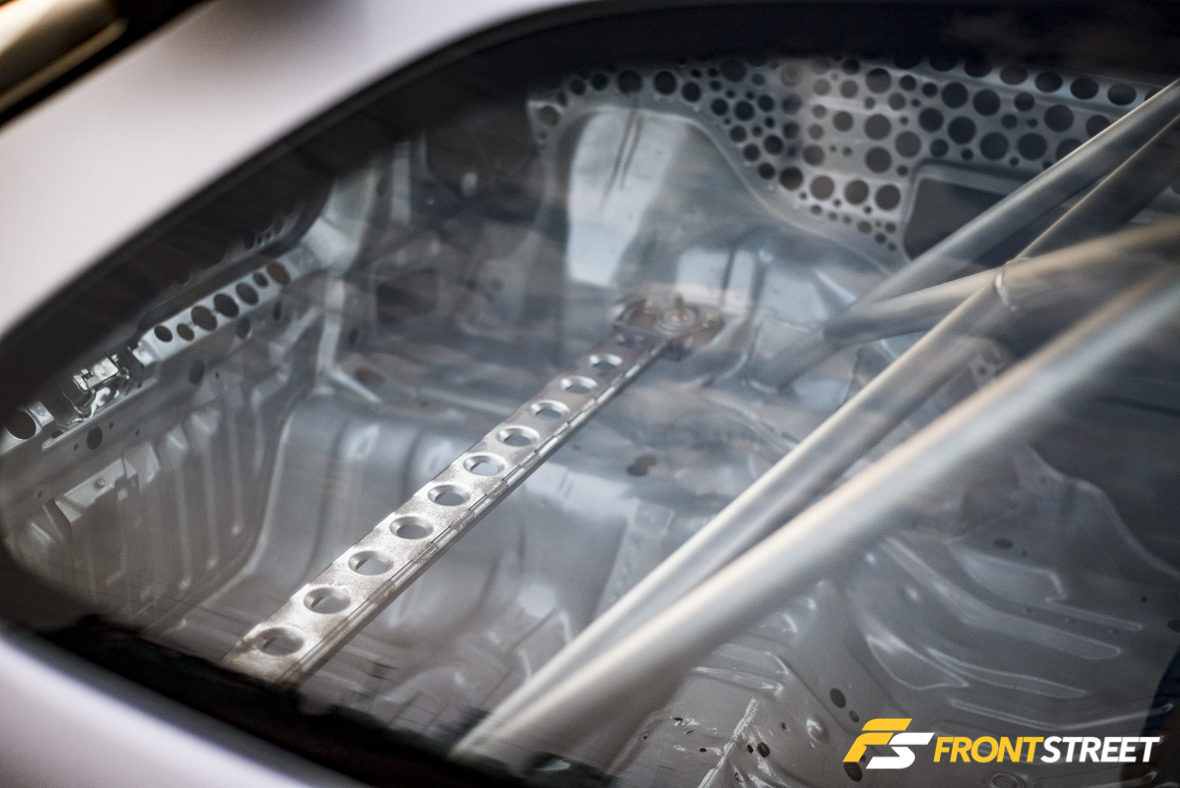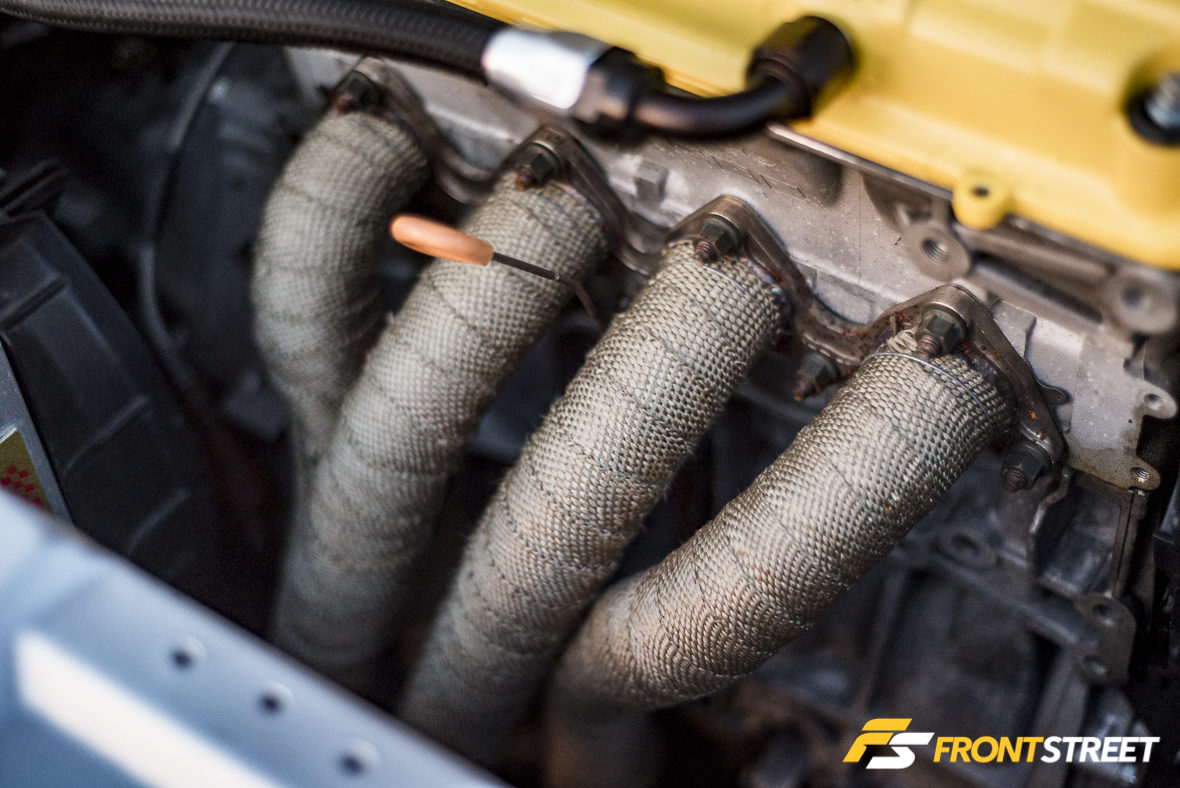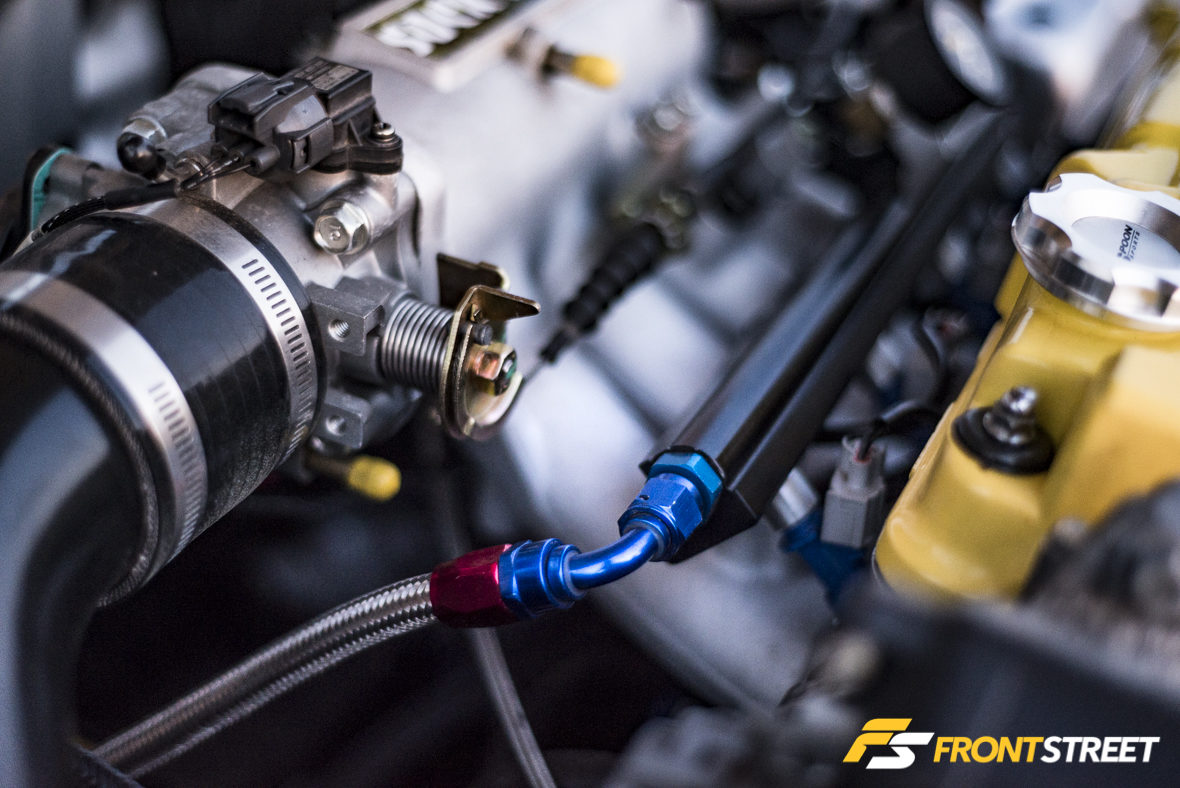Everyone on the planet knows at least one person who’s naturally talented at anything they try—a golden boy. For my group of friends and I, that person is Kyle Frederick, except his Golden Boy nickname extends further than just our friends to anyone he meets (it was even his Instagram handle at one point). He excels at everything he has ever tried to do. So what is the outcome when he builds his own 1997 Honda Civic for high-performance driving? I present you with the story of The Golden Boy and The Silver Fox.


He’s someone who was rumored to have successfully backflipped on a snowboard his first time being strapped into one. Within a couple days of buying a dirtbike he was riding twelve o’clock wheelies—a trick where the bike is ridden while completely vertical on one wheel. When we go cliff jumping, he chooses to effortlessly gainer into the unknown depths of the water before jumping in normally. After beginning his career as a Union Ironworker (Local 401, rep!), he was almost immediately put into his union’s skills challenge where he competed nationwide against other apprentice ironworkers. He was sponsored as an athlete in multiple sports while many of us were still struggling to talk to girls. He’s also currently in the midst of domesticating a wild squirrel—but that’s a long story.
It’s not even the fact that he attempts or succeeds at all of these things; it’s the grace with which he is able to perform them, and the blatant disregard for any consequences. Frederick’s most frequently used words are “I wonder if”, as in “I wonder if I could (insert any normally difficult physical task)”.
At this point in our lives, our most commonly muttered phrases about him are often in an unsurprised tone, “Of course, Kyle did it”, or “he would win that”. I’ve even watched him fall (a rarity) while riding a wheelie at about 50 mph on a dirtbike, where the bike fell on top of him and slid across the ground. Of course, he escaped with only a small scratch on his ankle. Are you starting to understand the kind of person he is? Throughout all of these extraneous activities where he has excelled, his overwhelming love of automobiles remains a constant and driving force.


I originally met him some 15 years ago while working my first job at a local gas station. We both had an affinity for cars from the Honda marque, which grew into a mutual desire to modify them. His first car was a 1990 Honda Civic DX hatchback, which was shortly thereafter was given to his older brother, Ryan, who was in need of a car after his own CR-X was stolen. During his ownership of the Civic, Kyle had only whet his appetite for modifying a car by replacing some suspension pieces. It wasn’t until Kyle bought his second car, his own Honda CR-X, where the then-seventeen year old was able to experiment with the rigors of real vehicle modification.
First on the list was suspension work, then a dual-cam engine swap, followed by a dry nitrous kit, wheels and tires, and exhaust. It was a stout little car, but the exterior was neglected and all four fenders began to eat themselves. The rear quarter panels were rusting away in typical Honda fashion, while the misaligned front fenders each caught their respective doors and pinched in. With the help of his brother and friends, he cut out the deteriorating metal in the rear panel, and used fiberglass to patch the bodyline back to factory appearance. At the same time he also had a roll cage welded into the chassis. He took the car to the dragstrip and ran an impressive 13.9-second pass before eventually selling the car in pursuit of a newer project.


Over the next years he owned a few other Hondas, a Harley motorcycle, and other cars. He tinkered with all of them to some degree, including an Acura Integra, which was broken into and had every single wire cut inside, and an Accord that he didn’t get out of the impound lot after it was towed. The most important vehicle however, was a black 1996 Honda Civic, which followed him from Pennsylvania out to California for a few years. Things took a more serious turn when he returned back to Pennsylvania from California with the intentions of more track time with his friends.
He had already swapped an LS Integra engine with a limited-slip transmission into his trusty black Civic years before. Although it was underpowered compared to our cars, in typical Golden Boy form, not only did he have no issues keeping up with our cars at the track, he managed to set the fastest lap time out of all of us. Unfortunately, an incident involving his black Civic, his mom’s driveway, and the rear bumper of her car resulted in a pretty hefty dent on his rear quarter panel—and an unforgettable Instagram post from his mom reading “Oops :(”. In his eyes, the car was tainted and he would need to start over with a different chassis to satisfy the picturesque car he really wanted.


And so began the quest for a new chassis to help bring his ultimate vision to life. He may have tapped into many different facets of vehicle modification on previous cars, but had never culminated them all into one complete piece—a car he could proudly take to shows, meets, track events, or drive on the street when he wanted.
As a byproduct of a series of trades, a mutual friend in Virginia had acquired a Vogue Silver Metallic (VSM) Honda Civic shell and listed it for sale; Frederick hopped at the opportunity to own it. The body was in incredible condition, and it had stock suspension to roll around on. It was the perfect blank canvas to shape as he saw fit.
Utilizing the help of a friend, the shell was trailered back to Pennsylvania where he started building almost the entire car from scratch. With the exception of the roll cage, a dated Spoon Sports carbon fiber hood, and a fresh coat of VSM paint already on the exterior, there were no prior modifications to ease his build process.


Why does he call it the Silver Fox? The recipe is simple. First start with one part catchy quote from the Grandma’s Boy film, and then mix in the definition from Urban Dictionary and you’ve got your answer. Frederick often uses the quote to say hello to people—even prior to purchasing the Civic—so it fit nicely when he would greet his new chassis upon arrival. Also, the slang for a silver fox is an attractive older man (or woman) with grey hair, which also suits the Civic nicely as it is certainly not the newest car, but boy does it look good!

First on Frederick’s to-do list for the car was to deal with the roll cage welded in by the previous owner. Received with six points of contact to the chassis including door bars through the front, he decided four points of contact would be plenty and limited the cage to a four point roll bar. In an effort to save weight, while making it easier to enter and exit the car, the door bars and front dash section of the cage were removed.
In a continuing effort to save weight, we now arrive at the most noticeable and memorable modification to the car: the swiss-cheesed interior. (Trypophobics, may God have mercy on your soul!)

Frederick, a former long-time sponsored skateboarder, underwent a surgery to correct multiple untreated ankle fractures and injuries during the first few months of ownership. This put him out of work for several weeks, and rendered him basically immobile. However, one thing he could still do, was operate a drill.
“This is what happens when you’re not working and have a drill,” laughs Frederick.

Using a few different holesaw drill bits, he artistically tackled each panel separately. Starting first by covering the most surface area with larger holes, while filling in smaller holes wherever there was still material to remove afterward. In total, there are currently over a thousand additional holes on the interior of the car.
Now, there are two things most people say to this:
1. “He ruined the rigidity of that car! That’s a unibody!” Yeah, it is a unibody, but the rear skeleton surrounding the quarter panel really isn’t structural at all. The rigidity comes instead from the thick steel framerails lining the underside of the car; he made sure to maintain their structure.
2. “Then why didn’t he just cut the whole panel out?” Well, because he had a drill and a lot of time to kill. That’s why.



He also removed all of the ducting under the dash, almost every electrical unit inside the car (heater, blower motor, radio, etc.), and excess material from the dashboard itself, all in the name of shedding weight. He also fabricated a custom C-pillar bar, and added a Circuit Hero rear strut bar to firm up the lightened rear.



To connect the driver to the car, Frederick settled on a set of F1 Spec bucket seats, Cipher 5-point harnesses, a Momo Mod78 steering wheel with accompanying NRG steering hub and ASR hub spacer. He also sourced a first-generation Fastline Performance shifter, a Spoon Sports Duracon shift knob, and an Omnipower Tachometer addition to aid in gear changing duties.


He might be able to do a lot of things, but heel-toe downshifts just aren’t one of them. As a solution to an ongoing struggle (something he actually has to learn), he fabricated himself a pedal extension to minimize the distance between his brake and gas pedal.
Moving onto the power plant, Frederick had previously experimented with rebuilding an engine to OEM specifications and also doing aftermarket head work, but had never built a complete motor for performance until The Fox. After spending majority of his driving time in an underpowered car, he had a vision of high-revving naturally-aspirated power wielding him around the track.


To complete his vision, he located a B18C GS-R engine and got to work installing 11.5:1 JE pistons and Brian Crower lightweight rods. A Moroso baffled oil pan joins the OEM bearings and gaskets to make up the bottom end. In the head, it’s all Brian Crower as the sport compact engine mecca was chosen to provide Stage 2 camshafts along with valves, springs, and retainers. The power is transferred through an ACT 6-puck clutch, and Streetlite flywheel within the limited-slip-equipped Civic Type R transmission. The spent air and fuel mixture is expelled through a wrapped Feel’s Honda Twincam header, and out through the modified Fujitsubo exhaust system.


Cold air is collected via a custom handmade duct from New Zealand fitted into the front bumper, then travels through a re-ducted OEM airbox and Spoon Sports Kevlar intake elbow—matching the plug wire cover—and finally entering the engine through the 68mm throttle body.



Gasoline is sent from a Walbro fuel pump through custom stainless braided lines with AN fittings, to a K-Tuned inline fuel filter, before finally entering the engine through an AEM fuel rail and Acura RDX injectors. The commands for these components are sent through a mil-spec RyWire tucked engine harness, which rids the chassis of brittle OEM wiring while also cleaning up the underhood appearance.

One thing Frederick has always been proud of is the ability of each of his cars to take turns quickly. With this project, he started by fitting Energy Suspension polyurethane bushings into each possible location. He furthered the elimination of play in the suspension by running BWR spherical rear lower control arms, an ASR subframe brace, 24mm swaybar, and spherical endlinks. Up front, Hardrace upper control arms provide necessary camber adjustability, while Buddy Club Sport Spec coilovers at all four corners handle ride height and damper adjustment.
Once the car was running, its maiden voyage—and several more—were taken in this form, but he wasn’t gaining comfort with the new chassis. This led to some added changes, which brought the car to its final specifications. To make the car feel more planted, Frederick decided he needed a wider track, more braking force, and a little aerodynamic help.



Although he had retained the stock 4-lug hubs, he wanted to sure up the car’s contact patch while also increasing the braking potential. He purchased a rare set of 4-lug, 16×8-inch +42 offset Volk Racing TE37 wheels and wrapped them in 225/45/16 Toyo R888R tires. Underneath, he elected to use Wilwood’s full Big Brake Kit including their Dynapro 6-piston front calipers, 12.2-inch two-piece rotors, and stainless steel braided lines. To complete the new braking system, he fabricated his own master cylinder brace, and also installed an EM1 Civic master cylinder, and rear disc brake conversion.
The last piece of the puzzle lies on the exterior of the car, where his initial additions of Civic Type R headlights, JDM side moldings, the aforementioned intake duct, and Spoon Sports carbon fiber hood were not quite enough.


Unhappy with the aero options on the market, Frederick created his own splitter and air dam setup using Devsport splitter brackets, Birch wood, and a plastic gutter guard system. This combination is sure to accurately direct the air where it is needed, while providing added front downforce. In the rear, The Fox received a Voltex Type 1 carbon fiber rear wing mounted to a Civic Type R wing base at the top. Underneath, it uses a custom handmade flat-bottom-panel Frederick created himself, and a Top 1 Motors diffuser to quickly direct low-pressure air out from underneath the car. The overall combination helps to suck this silver Civic to the ground for more grip and quicker lap times.



Now in its final form—or should I say current form—The Silver Fox weighs a feather light 2,080 pounds. The Golden Boy has touched each and every inch of this car, and modified the entire thing almost by himself. To really put the cherry on top, Frederick can accept full praise because he created countless pieces of the car strictly for his own use. He didn’t build it from a catalog; he built it by himself, for himself.



In the end, being naturally talented at everything didn’t necessarily mean he would shine at building cars, but when your passion for automobiles lies deeper than any other activity the true motivation reveals itself. Throughout a few unfortunate events with previous cars, and seemingly constant change of direction in his life, he has finally settled down with his truest vision of the Honda he always wanted. Perhaps this year—with the help of his silver sidekick—he can once again claim the fastest lap time, and return to golden status yet again.









































